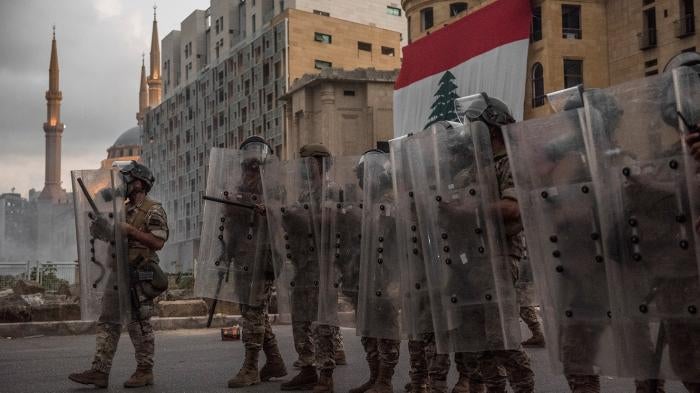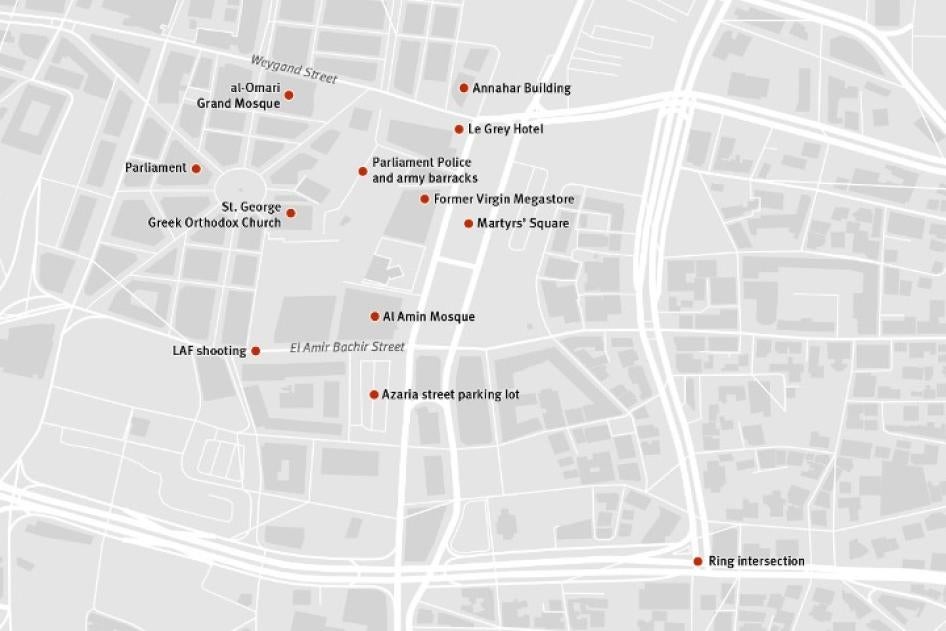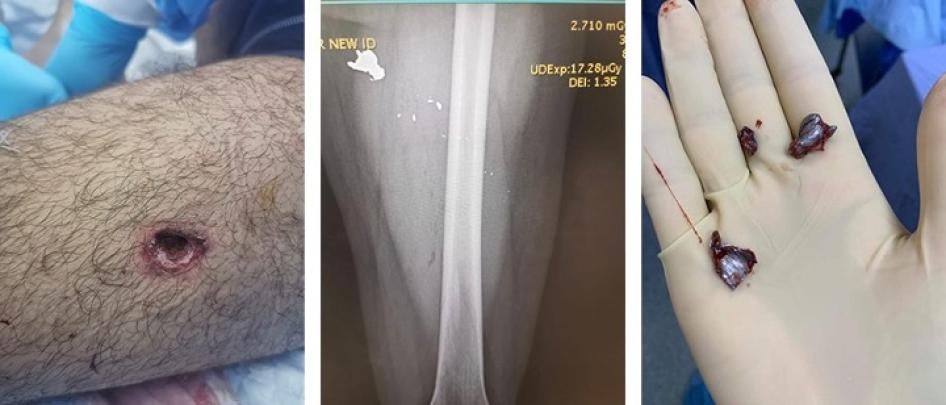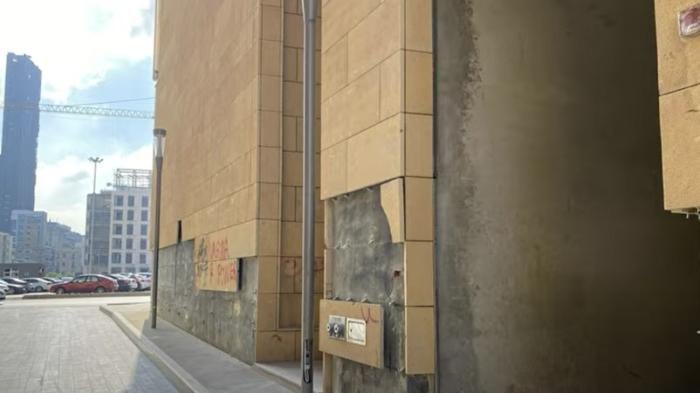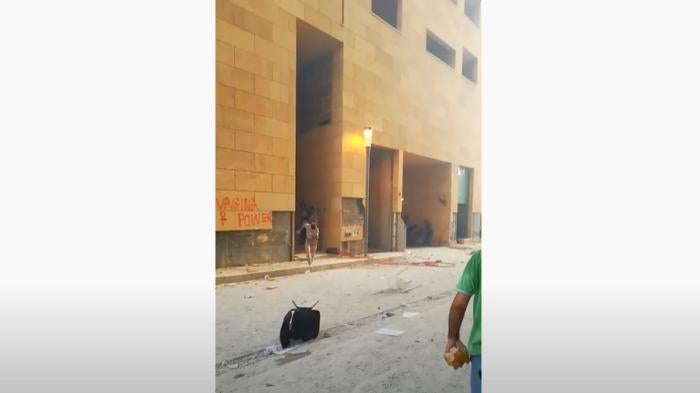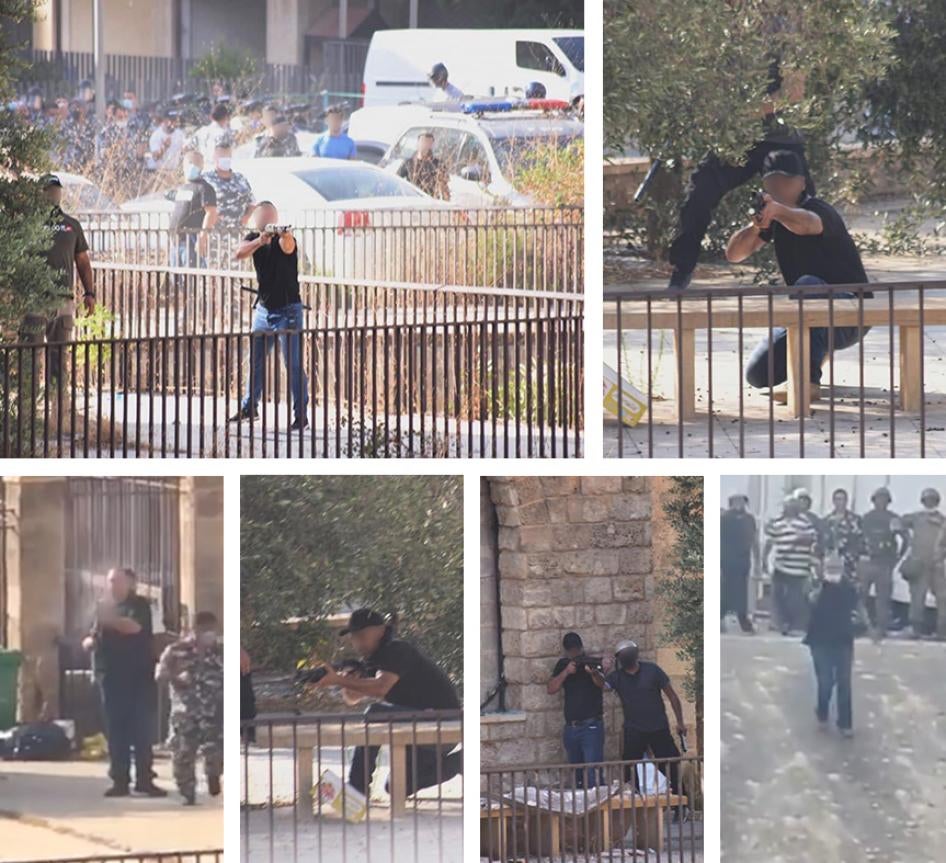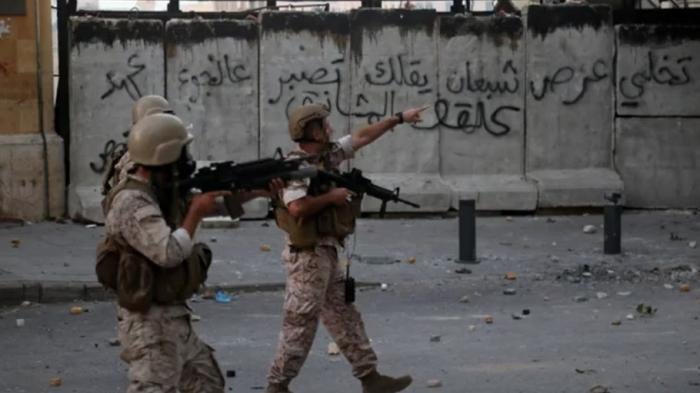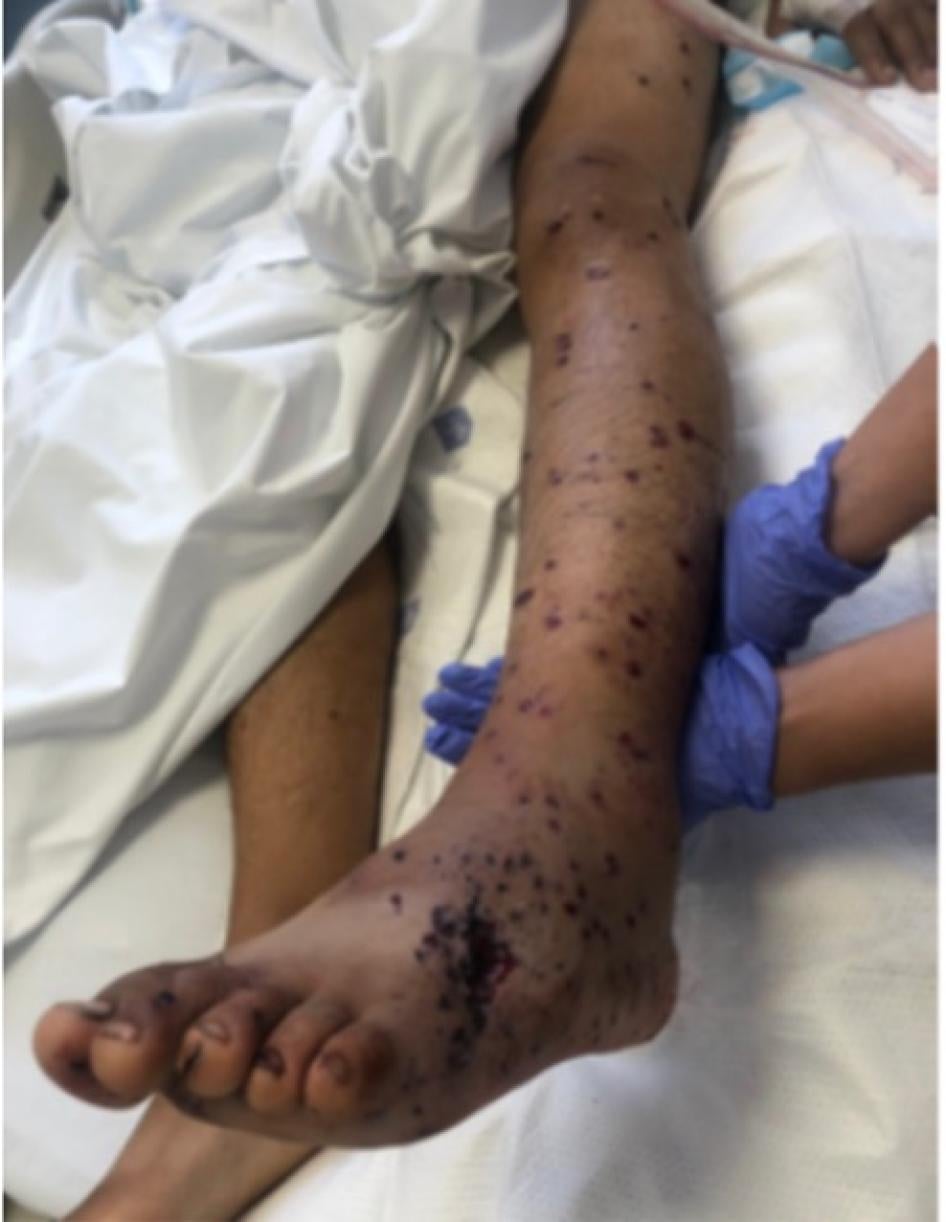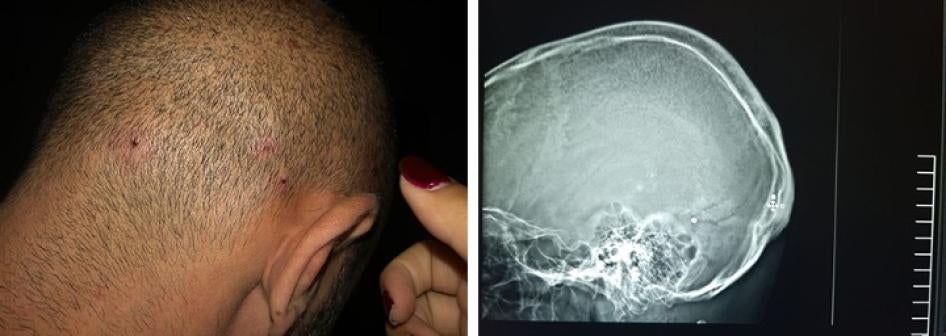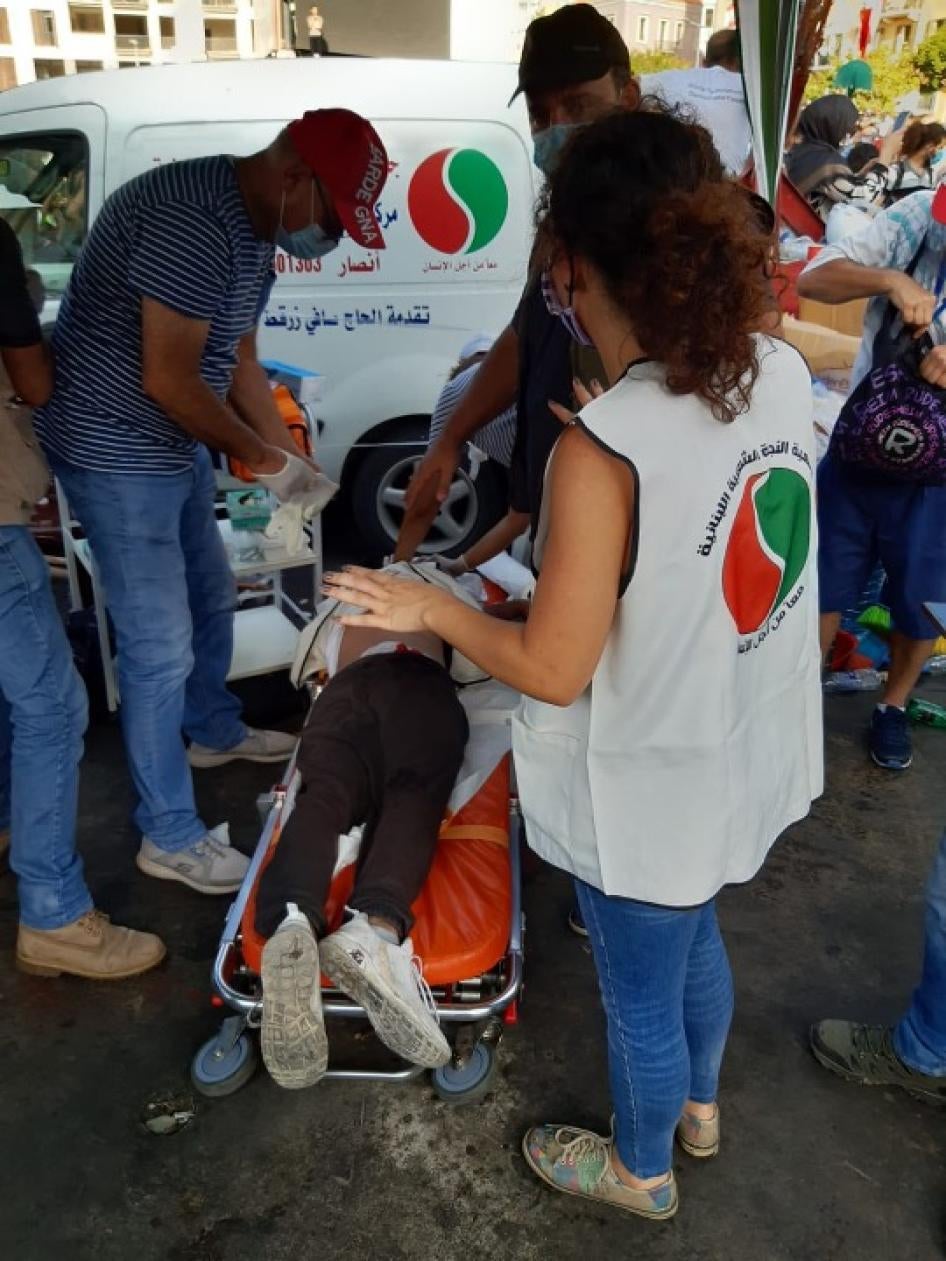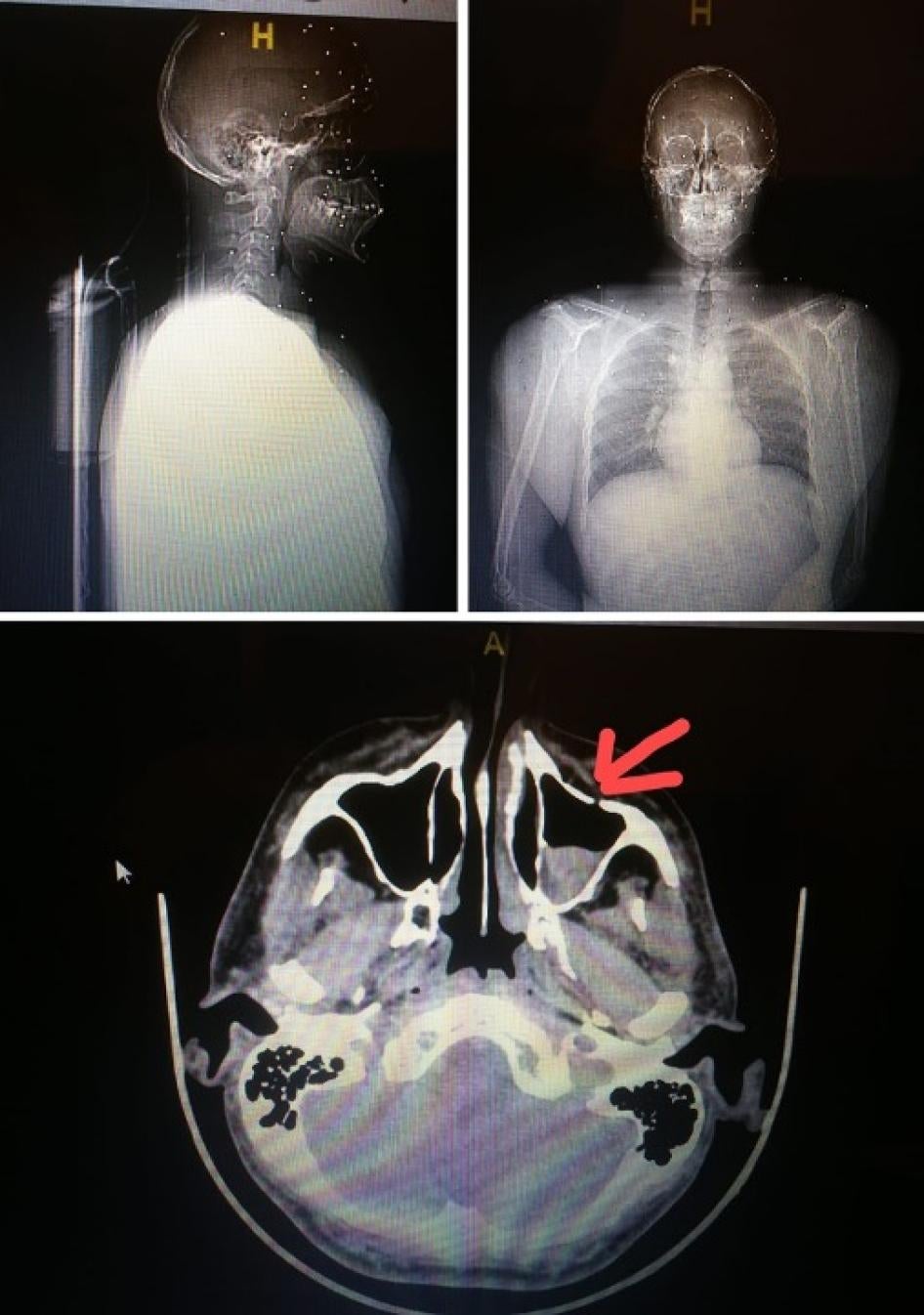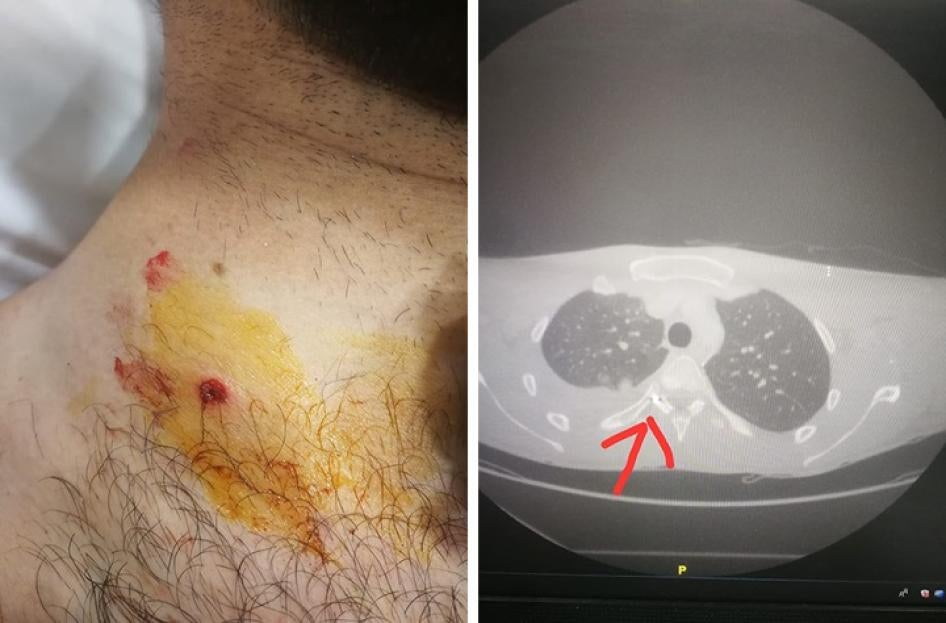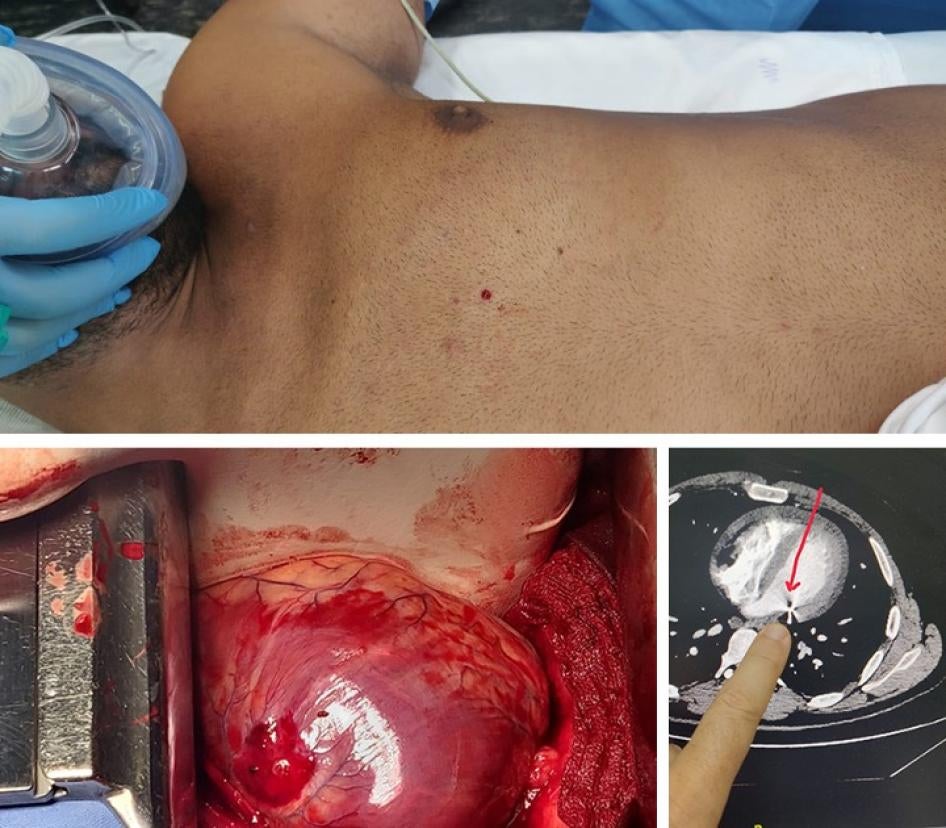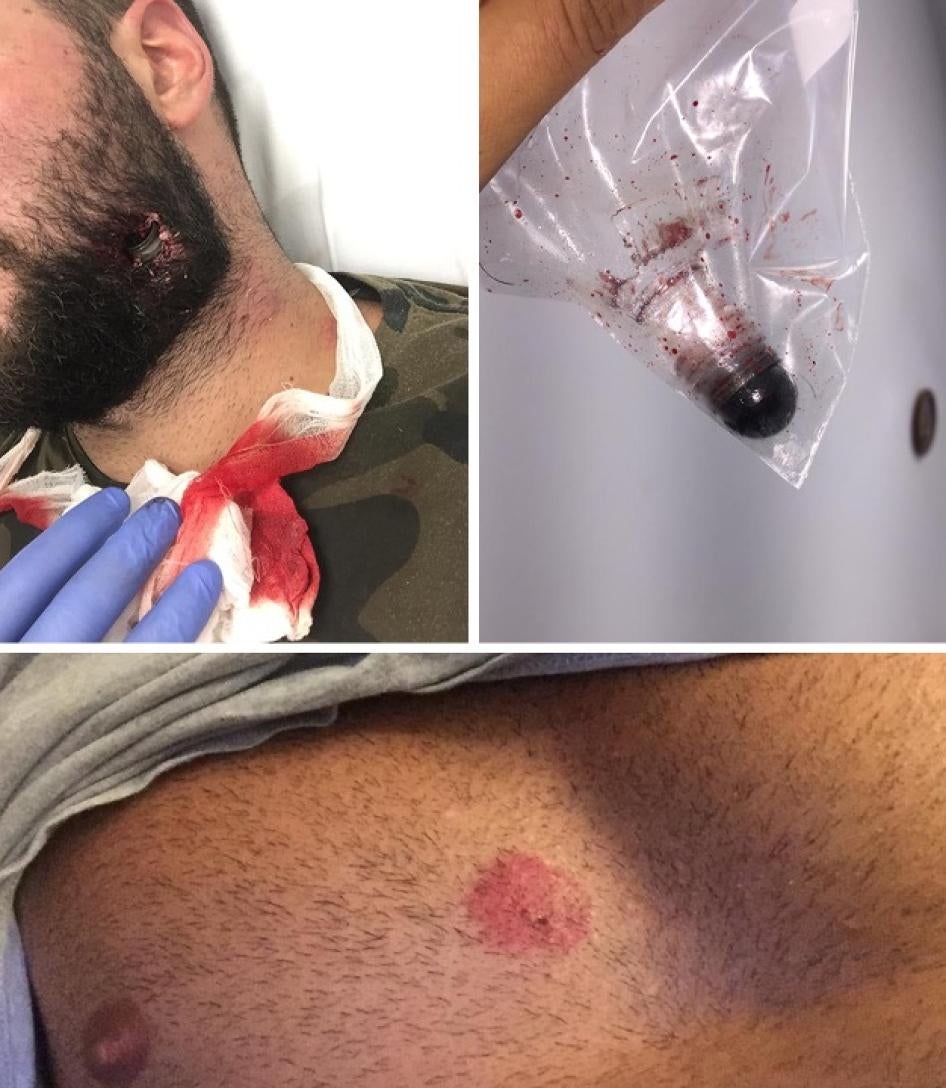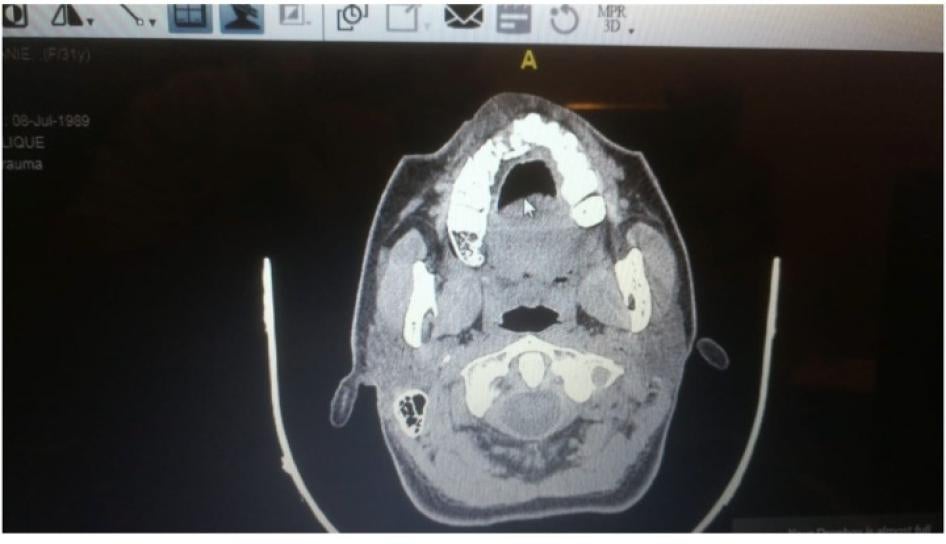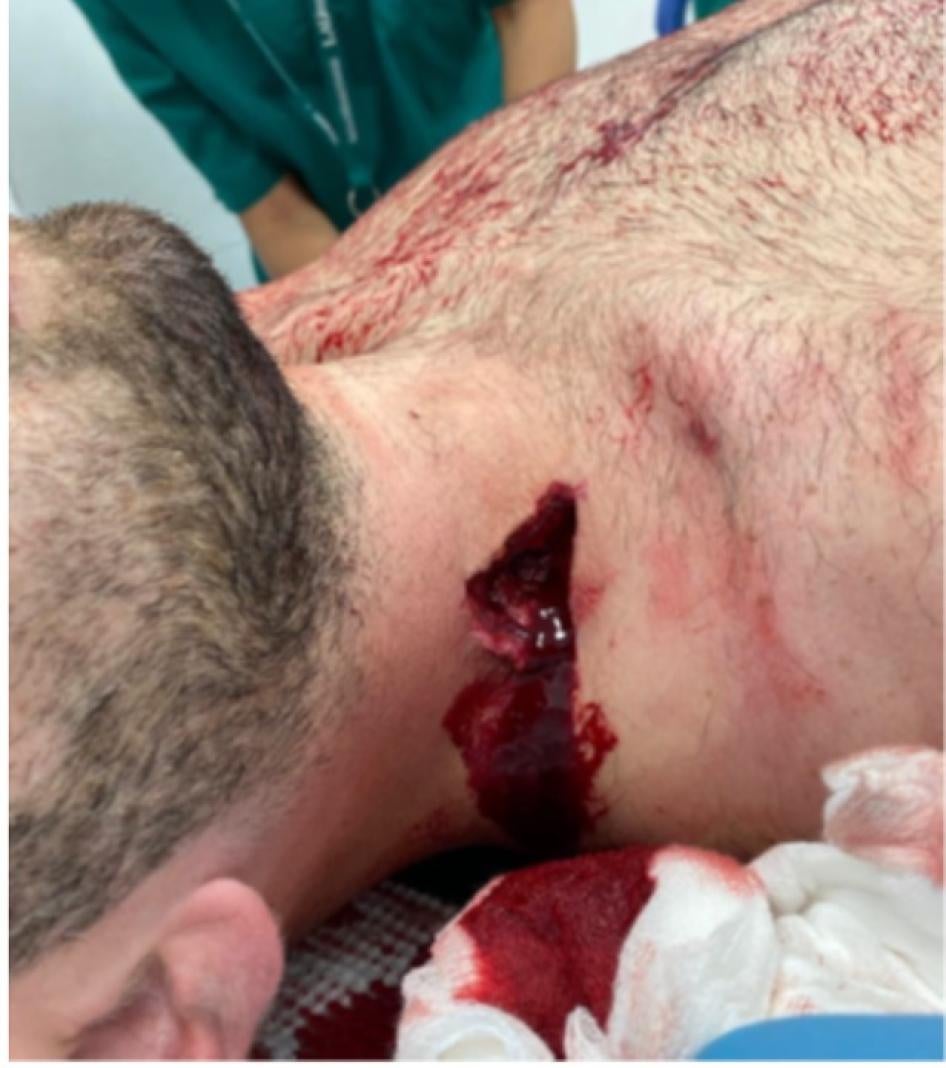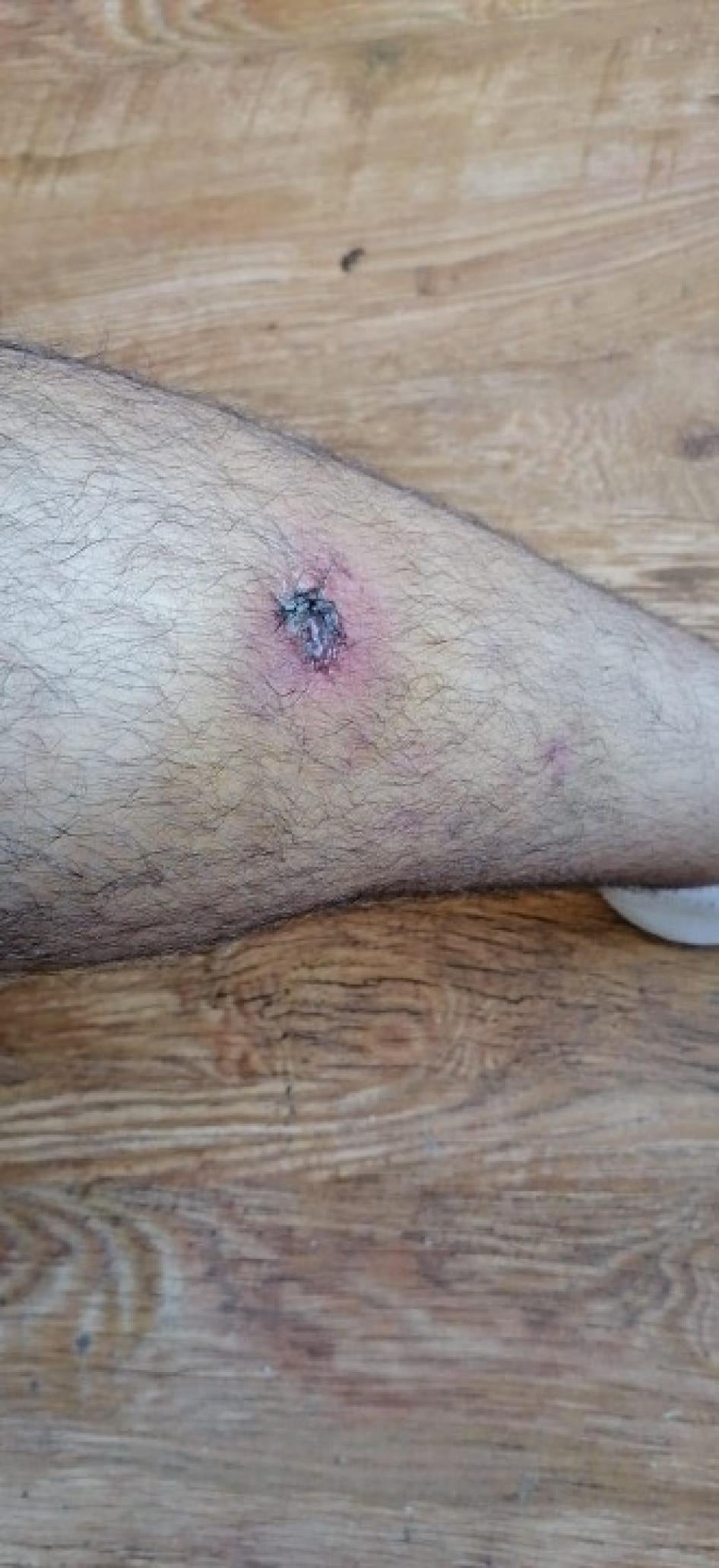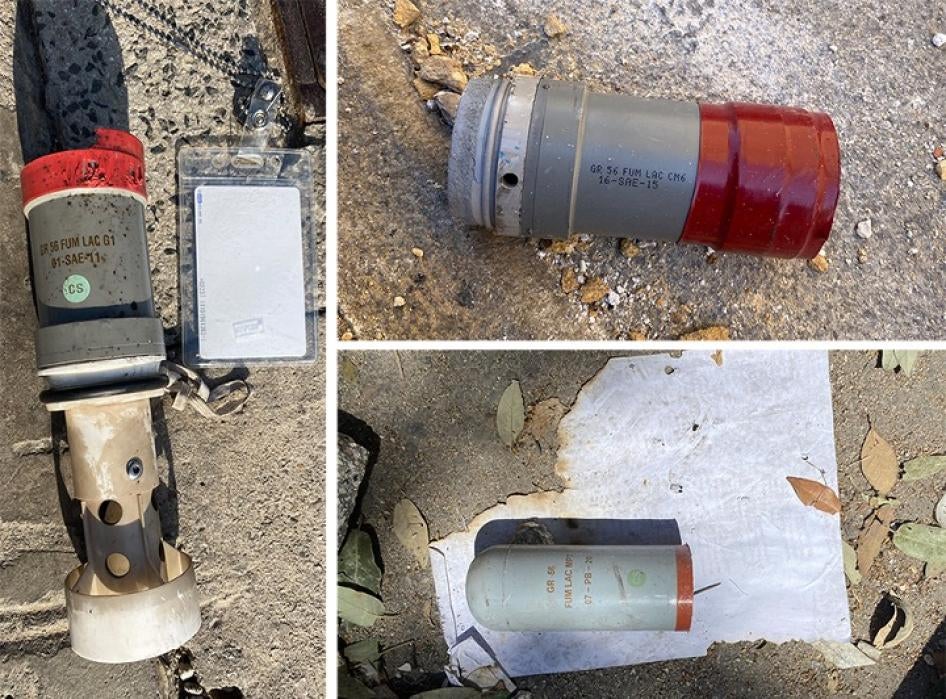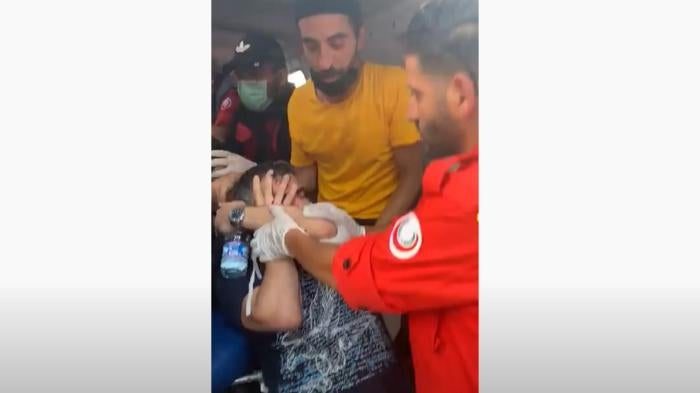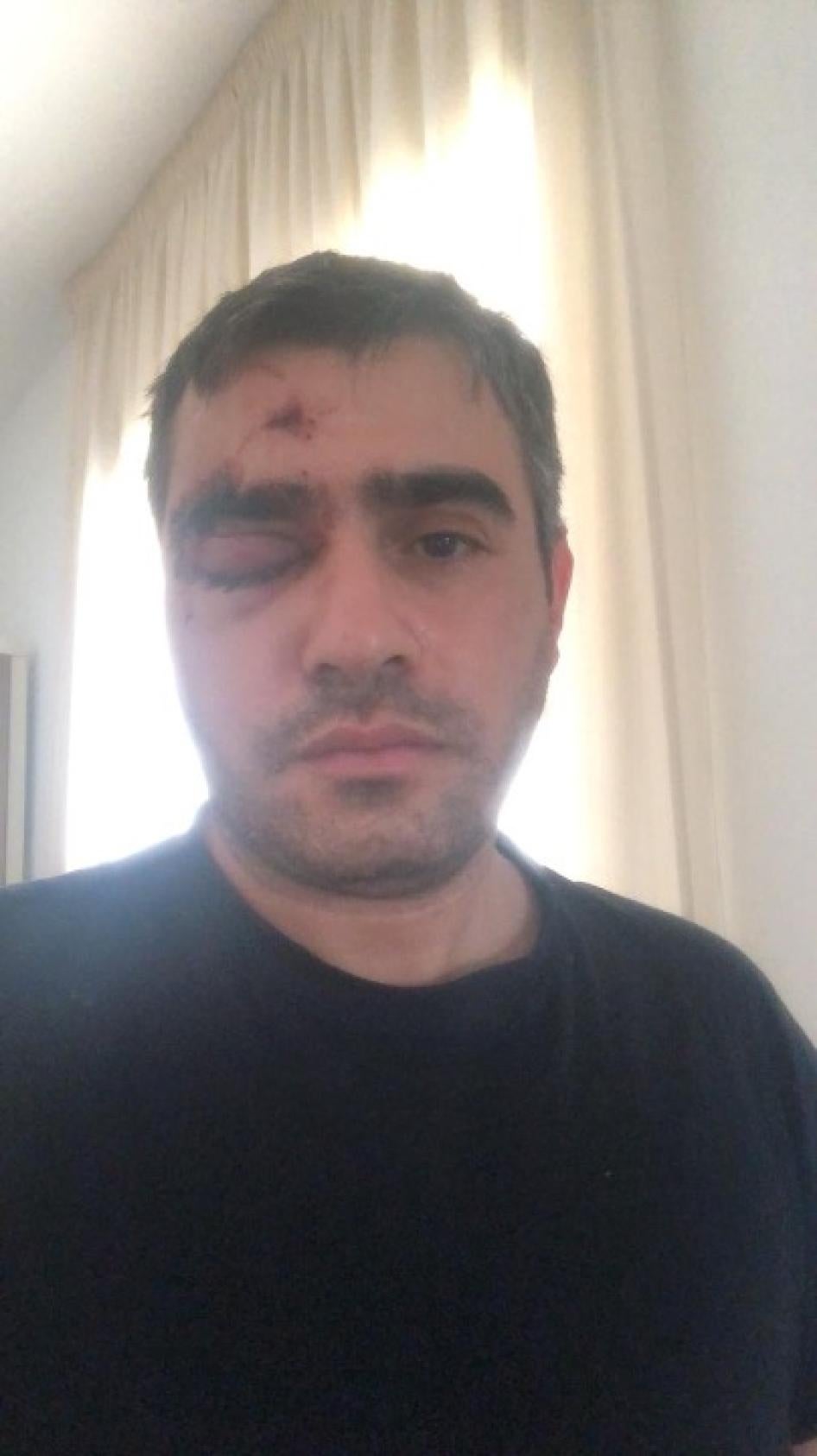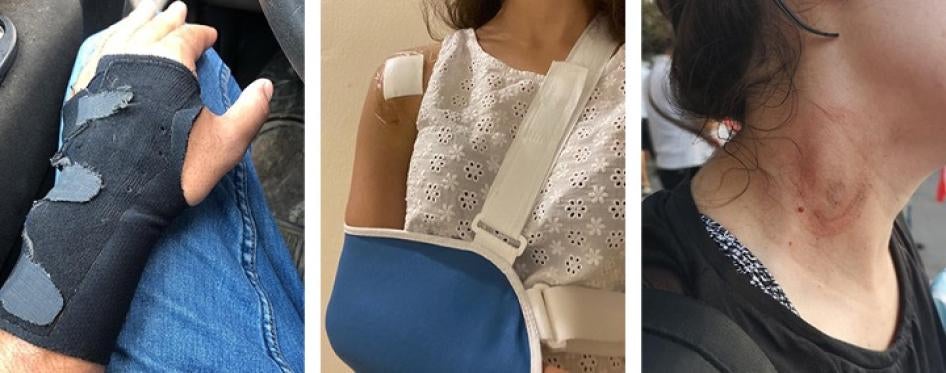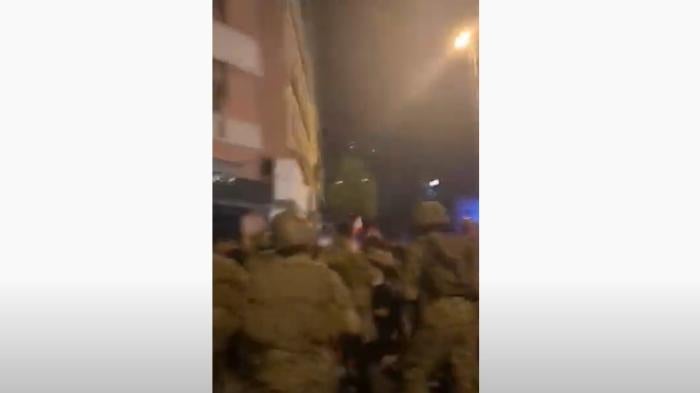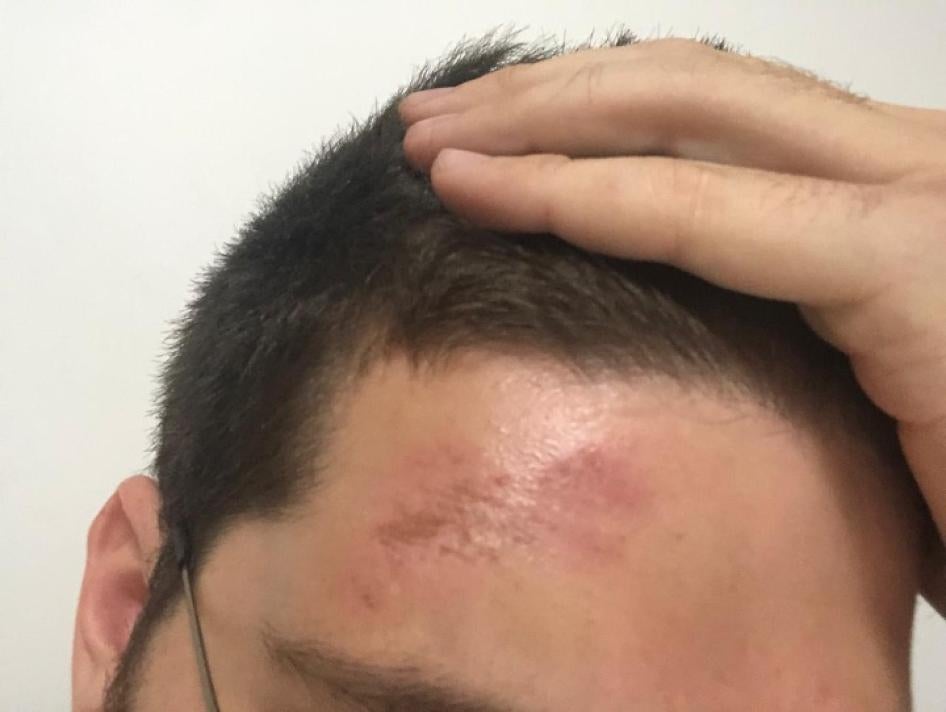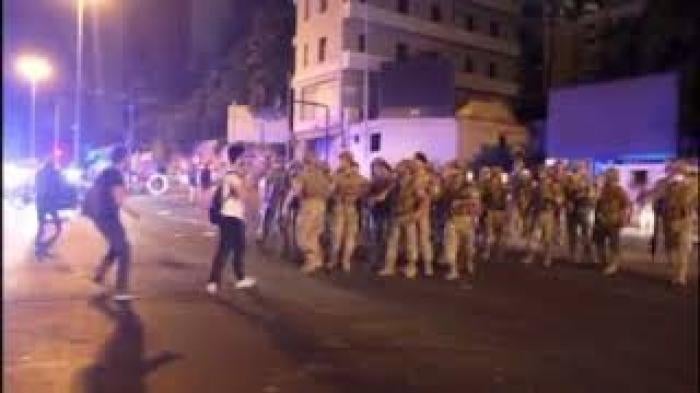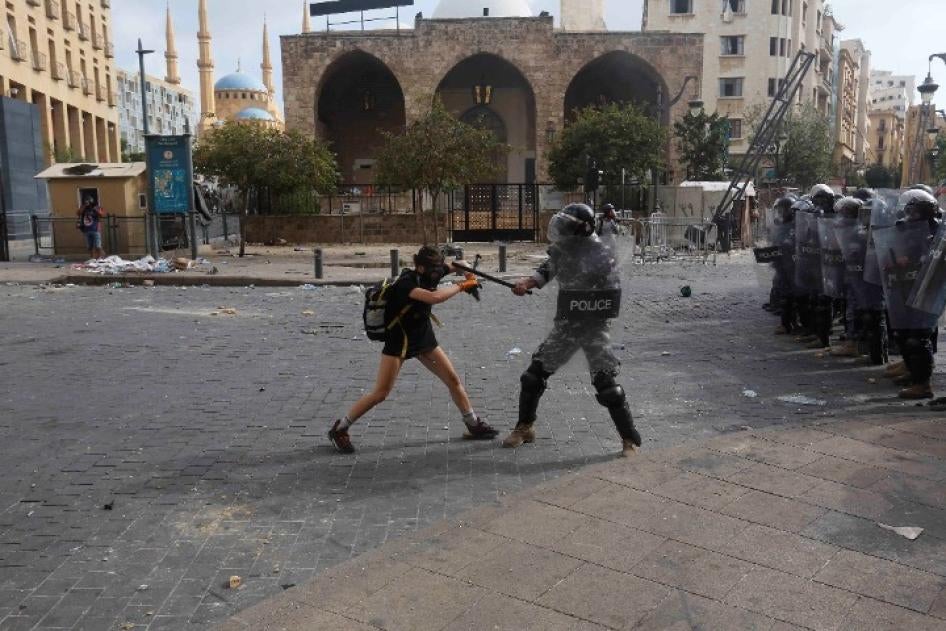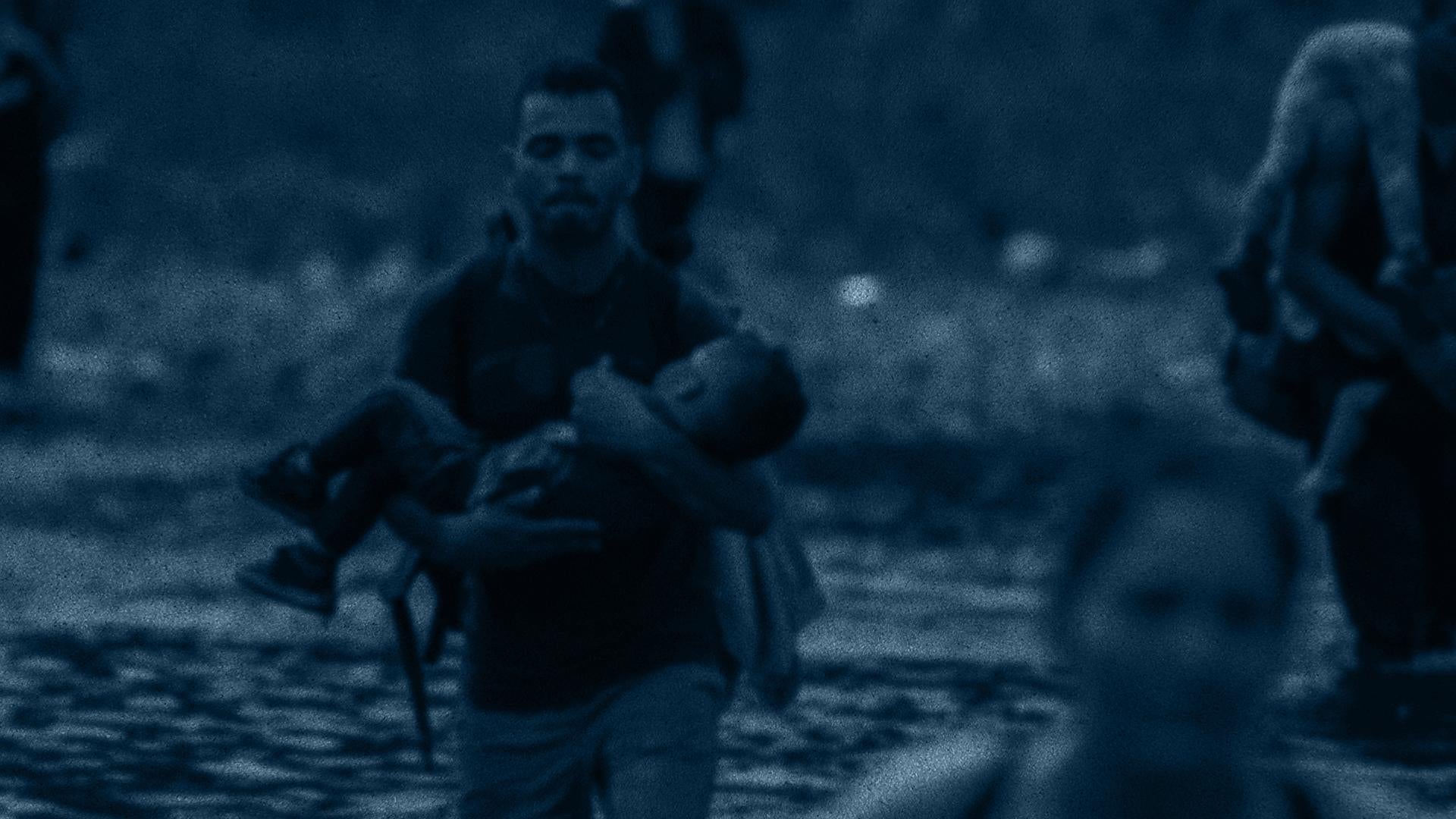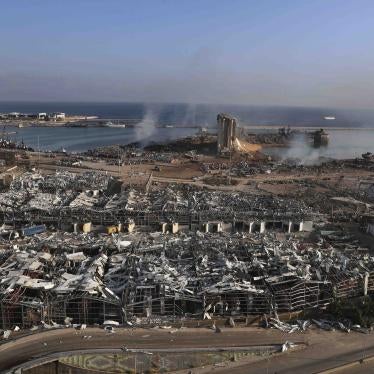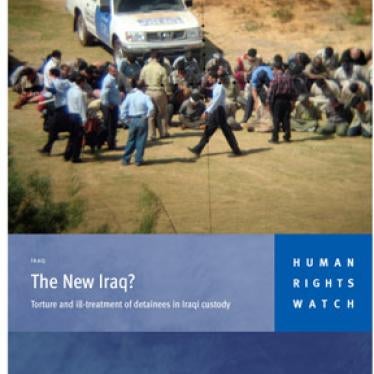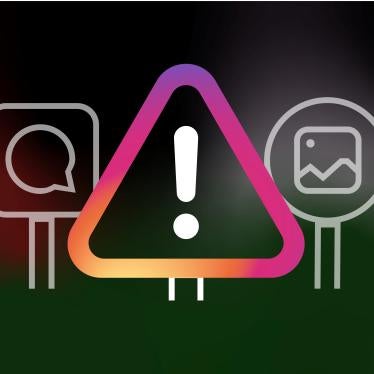Update: The Internal Security Forces (ISF) responded to Human Rights Watch's letter on September 14. They denied that their members used live ammunition, rubber bullets, or metal pellets during the August 8 protest in downtown Beirut, but said that the Parliament Security Force, comprising Parliament Police and an army company, did use these weapons. The army has not yet responded to Human Rights Watch's letter, and the Parliament Police declined to comment.
(Beirut) – Lebanese security forces used excessive and at times lethal force against mostly peaceful protesters in downtown Beirut on August 8, 2020, causing hundreds of injuries.
Security forces fired live ammunition, metal pellets, and kinetic impact projectiles such as rubber balls, including at health workers, and police deployed excessive quantities of tear gas, including at first aid stations. Several teargas cartridges were fired directly at protesters, striking some in the head and neck. Security forces also threw stones at protesters and beat them. The forces involved included the Parliament Police, the Internal Security Forces (ISF), the Lebanese Armed Forces (LAF), and unidentified forces in civilian clothing.
“Instead of lending a helping hand to fellow Beirutis still digging themselves out of the explosion debris, Lebanon’s security apparatus made a fist and pummeled protesters with shocking amounts of violence,” said Michael Page, deputy Middle East director at Human Rights Watch. “Such unlawful and excessive force against mostly peaceful protesters shows the callous disregard of the authorities for their own people.”
Tens of thousands of protesters had gathered in downtown Beirut on August 8 to express their outrage over the government and political elites’ incompetence and corruption. These political elites are widely blamed for the August 4 blast at Beirut’s port, which killed 180 people, injured more than 6,000, and caused extensive damage across the city.
Human Rights Watch researchers monitored the protests and interviewed 25 people in Beirut between August 8 and August 18, including doctors and other health workers, journalists, and lawyers. Human Rights Watch also photographed and collected fired munitions from the protest site and analyzed photographs and videos of security forces using excessive force that were sent directly to researchers or collected from social media platforms. Researchers identified the weapons security forces used and reviewed medical reports of injured protesters.
Human Rights Watch submitted questions about security forces’ conduct to the army on August 18 and the ISF on August 19, but as of August 25, has not received a reply. Human Rights Watch contacted Parliament Police on August 19, briefly summarized the findings, and asked for comment. An official, who refused to give his name, said “interview over” and hung up.
Some protesters interviewed had been injured by live ammunition, rubber balls, metal pellets fired from shotguns, or direct fire from teargas cartridges. Others were hit by members of the security forces with bare hands, sticks, and other weapons. The Lebanese Red Cross and the Islamic Emergency Relief Corps announced that 728 people were injured during the August 8 protest and at least 153 of them were taken to hospitals for treatment.
Security forces should immediately end the use of shotgun-fired metal pellets and other indiscriminate area-fire ammunition, and the public prosecutor should open an independent investigation into the abuses and make the results public, Human Rights Watch said. International donors to Lebanese security forces should investigate whether their support is going to abusive units, and if so, halt it immediately.
Most demonstrators were peaceful, but some threw rocks, fireworks, and Molotov cocktails at security forces. Some also looted and burned public and private property. Protesters briefly occupied the Foreign Economy, Environment, and Energy Ministries, and the Association of Banks.
The ISF announced that one of its members died while trying to save people trapped at the Le Grey Hotel and said 70 of its members had been injured. The army stated that 105 of its soldiers had been injured, including 2 in critical condition.
The use of violence by some protesters does not justify the excessive and at times unprovoked use of force by security forces, Human Rights Watch said.
The ISF’s Riot Police and Parliament Police wear the same dark blue camouflage uniforms with anti-riot gear and are impossible to distinguish. Parliament Police claimed that their duties are limited to protecting the parliament building and that parliament’s perimeter is secured by the ISF and Lebanese army. However, high-level government and security officials told Human Rights Watch that Parliament Police were responsible for serious abuses against demonstrators outside the parliament compound in December 2019.
Human Rights Watch documented, from multiple sources, the use of live ammunition at or toward protesters on four separate occasions on August 8. In one case, two soldiers fired their assault rifles in the direction of protesters. The identities and affiliations of the shooters in the other three cases are unknown.
In one of these three cases, security forces fired live ammunition at protesters attempting to evacuate an injured man. Human Rights Watch spoke with one protester from another incident who said he was injured in his thigh near Le Grey Hotel by a live round and reviewed his medical records, showing bullet fragments in his thigh. In two instances, the shooters were in the parliament compound surrounded by uniformed members of the army and police who did nothing to stop them.
Metal pellets fired by shotguns were the main cause of many serious injuries on August 8, including injuries to protesters’ eyes and vital organs. Human Rights Watch had not previously documented the Lebanese security forces’ use of metal pellets. Given their inherently inaccurate nature, indiscriminate impact, and evidence of the serious injuries they have caused, the use of shotguns firing multiple pellets – rubber or metal – against demonstrators at any range should cease immediately, Human Rights Watch said.
The use of live ammunition when there is no imminent threat to life or imminent risk of serious injury, and the use of shotguns that scatter multiple projectiles indiscriminately over a wide area with the potential to harm anyone in their path, both violate international human rights standards governing law enforcement officials’ use of force.
In a statement on August 9, the Lebanese army said that “none of the soldiers opened fire with live ammunition toward protesters in downtown Beirut.” The ISF denied firing “live ammunition” and rubber bullets at protesters, and Parliament Police denied shooting at protesters.
Police dressed in anti-riot gear and members of the army also beat and kicked protesters, doctors, journalists, and a Human Rights Watch researcher, who was hit in the mouth.
Ghida Frangieh, president of Legal Agenda, a legal advocacy group, and member of the Lawyers’ Committee for the Defense of Protesters, an ad hoc group of pro bono lawyers, said that security forces arrested at least 20 protesters on suspicion of rioting and drug use. Frangieh said the security forces “illegally subjected” those arrested to drug tests at the ISF’s El-Helou Barracks, violating their rights to privacy and health.
Eighteen protesters were released after 24 hours, while 2 remain detained on charges unrelated to the protests, Frangieh said. Frangieh added that the Lawyers’ Committee submitted twelve criminal complaints to the public prosecution on August 24 on behalf of injured protesters against anyone who is found to have ordered the use of or used live ammunition, including civilians and security forces affiliated with the army, ISF, and Parliament Police.
Diala Chehade, a lawyer and human rights advocate, filed a criminal complaint against the Parliament Police on August 19 on behalf of a protester who was shot with a rubber bullet and lost his left eye.
A group of doctors known as the “White Shirts,” who in October had protested the impact of corruption and the economic crisis on access to quality health care, said on August 13 that the Health Ministry said it would not pay the expenses of hospitals that treated protesters injured in the August 8 protests. After pressure from doctors and hospitals, the Health Ministry apparently rescinded the decision.
The Justice Minister had asked the Chief Public Prosecutor to open an investigation into the events of August 8. As of August 25, the prosecutor had not yet publicly announced that he was doing so.
Under international human rights law, everyone has the right to freedom of expression and peaceful assembly as provided under the International Covenant on Civil and Political Rights (ICCPR), to which Lebanon is a party.
International donors such as the United States, United Kingdom (UK), and France have sold or given billions of dollars in arms, equipment, and training to Lebanon’s security forces, including the Lebanese army and the ISF. Donors should review these programs and ensure that they are not providing weapons, equipment, or training to any forces involved in serious abuses against protesters, Human Rights Watch said. They should also use their leverage to press for credible investigations into the abuses and for those responsible to be held to account.
On August 5, Lebanon's government declared a two-week state of emergency in Beirut, giving sweeping powers to the army and placing all security forces under the army’s command. The state of emergency was twice extended, and is set to expire on September 18.
“Lebanese authorities can’t beat the smoldering grievances out of their citizens and think that they will escape accountability,” Page said. “To send a strong message that this type of abuse will no longer be tolerated, those responsible for beating and firing live ammunition and metal pellets on peaceful protesters need to be held to account.”
Warning: distressing imagery below.
Excessive and Lethal Force Against Protesters
International standards stipulate that security forces should use the minimum necessary force at all times. In dispersing violent assemblies, firearms may only be used when other less-harmful means are not practicable but must still be used to the minimum extent necessary. Law enforcement officers may only intentionally make lethal use of firearms when strictly unavoidable in order to protect life. Live ammunition should not be used unless required to protect life or prevent serious injury.
Live Ammunition
Human Rights Watch documented the use of live ammunition at or in the direction of protesters on three separate occasions on August 8, and the firing of live ammunition in the direction of protesters, but at a high angle, on another occasion. No protesters or bystanders are known to have died in these incidents, but at least one was injured by a bullet from a pistol.
Throughout the afternoon of August 8, Human Rights Watch researchers observed large protests around the Annahar Building in downtown Beirut, with protesters charging the areas around the parliament building, pulling down barricades, setting fire to material, and at one point using a vehicle to block the road. Protesters threw debris at security forces, who responded with a high volume of teargas. As the protests continued, security forces escalated their response to include shotgun-fired metal pellets and live ammunition.
One protester, Omar, who like others asked that his last name not be used for his protection, said that at about 7:30 p.m., he was peacefully demonstrating near the Le Grey Building and an adjacent alley on the “front lines” of the protests. He heard gunfire and saw two people firing at protesters. One, dressed in jeans and a black T-shirt, fired a handgun at Omar, who hid behind a wall.
During a lull in the gunfire, Omar said, he left his hiding place and the same person shot at him from a distance of less than 10 meters, striking Omar in the upper left thigh. “When he first shot, I didn’t feel it,” he said. “I looked down and saw that my leg was bleeding. I wanted to retreat, but I took two steps and fell over.”
Human Rights Watch reviewed Omar’s medical records from August 8, including X-rays, which showed three large bullet fragments and several smaller fragments in his left leg. “Fortunately, it didn’t hit my bone,” he said. “It was close to an artery, but it narrowly missed it.”
In another incident, around 6:45 p.m., security forces perched near a wall inside the compound belonging to the Parliament Police, responding to persistent rock-throwing, fired multiple live rounds at protesters in an alleyway, where a Virgin Megastore was previously located. One protester in the alley, “Joe,” another protester whose name is not being used for his protection, said he saw three security force members with shields, helmets, body armor, and dark colored uniforms repeatedly firing un-aimed and aimed shots at protesters with pump-action shotguns.
He said he peered around the corner and a shot narrowly missed his head, striking the wall behind him at around head level. A Human Rights Watch researcher later visited the site and identified fragments of a metal-jacketed projectile and spall embedded in the wall about two meters from the ground. The metal fragments in the wall had a bright shine, indicating the impact was recent.
Joe said he fled the area, but seconds later, at approximately 6:48 p.m., security forces fired at least 2 additional rounds at 3 men as they tried to carry an injured protester to safety. Human Rights Watch verified a video of the incident that was posted on Facebook on August 8 and spoke with the man who took the video. The video shows three men in the alleyway in the recessed entrance to an underground parking lot hoisting a man up and carrying him towards Martyrs’ Square as gunfire is heard and projectiles hit the wall near them.
At the scene, Human Rights Watch found damage consistent with that of live ammunition, including fragmentation of jacketed bullets embedded in the wall. The metal fragments still visible in the wall had a bright shine, indicating the impact was recent, and there have not been any other known incidents of gunfire in this area of Beirut since 2015.
On the same day, several photographs and videos circulated on Twitter and Facebook that showed at least four instances of men wearing black T-shirts and blue jeans shooting or aiming to shoot with pump-action shotguns, handguns, and semi-automatic rifles at protesters near the army barracks in downtown Beirut while standing alongside ISF and LAF uniformed personnel. It is unclear what type of ammunition they were firing. In one of the videos posted on Twitter on August 8, a man wearing a black T-shirt and blue jeans can be seen standing alongside approximately 30 others, both in and out of uniform, by the Parliamentary Police and army barracks near the Le Gray Hotel. In another video posted on Twitter, the same man is seen running down an incline while firing at least seven rounds from a handgun, consistent with the discharge of live ammunition. The barrel can be seen erratically shifting laterally as the rounds are fired, indicating that he was firing the shots randomly.
Between 4:00 and 8:20 p.m., hundreds of protesters were in the line of fire from where the man was shooting and as close as 45 meters away. In the video, the members of the army and a uniformed member of the security forces who are next to him are doing nothing to stop the shooter.
Two soldiers also fired their weapons in the direction of protesters, firing at least eight rounds, either over their heads or at the ground in front of them, based on video and photographs verified by Human Rights Watch and a witness, Hasan Shaaban. Shaaban, who was photographing the soldiers, said the first soldier, who Human Rights Watch identified as an officer wearing the unit insignia from the Airborne Regiment, fired approximately 2 rounds at least once in the ground with protesters 5 to 10 meters away.
— Pan Troglodytes, PhD (@ChimpTales) August 9, 2020
Human Rights Watch reviewed and verified Shabaan’s photographs that show 2 casings consistent with the size and shape of the 5.56x45 millimeter round fired from the M4 assault rifle carried by the officer at the front of the formation. The casings are tumbling to the officer’s right side, consistent with the direction of ejection of rounds from an M4 fired in the direction of protesters. The ejection port cover on the M4 is also open, consistent with the weapon’s bolt having recently operated.
According to data embedded in the photographs, the images were taken at 7:26 and 7:27 p.m. on August 8. This is consistent with the twilight visible in the images and an earlier livestream broadcast by MTV Lebanon from the same location. Two videos recorded the same scene from slightly different angles and were posted on Twitter on August 9 and August 12. They show the officer gesturing in the direction of the main protest area.
A soldier to his right can be seen unslinging his rifle while moving ahead of the officer, angling his weapon upward and firing in the direction of protesters, many of whom are fleeing toward Al Amin Mosque and the parking lot near Azarieh Street. Immediately after he fired, the officer grabbed the second shooter and appeared to reprimand him, sending him to the rear of the formation. The uniforms worn by the soldiers, a multi-colored tan and brown digitized camouflage pattern, are consistent with those worn by the Lebanese army’s Airborne regiment. The officer, as well as at least one other soldier, can be seen in photographs taken around the time the video was recorded, wearing the unit insignia of the Airborne regiment on their upper right arms.
Shotgun-fired Metal Pellets
For the first time in Lebanon, Human Rights Watch documented several instances of Lebanese security forces using shotgun-fired metal pellets that wounded people. In some cases, security forces fired toward people’s upper bodies, including the head and face. Human Rights Watch reviewed medical records and X-rays, spoke to 3 victims and 4 doctors who treated them, and analyzed a pellet recovered from one person’s body, as well as a photograph of another. Additionally, the “White Shirts” doctors shared anonymized medical records of 13 patients seriously injured by the metal pellets.
Typical shotgun cartridges consisting of small-diameter metal pellets – of the kind documented and analyzed by Human Rights Watch – are sometimes referred to as “birdshot” or “dove shot.” While initially concentrated in a tight pattern as they are fired, the pellets in the cartridges continuously spread out to create a constellation that can reach several decimeters in radius within a few meters of being fired.
The United Nations guidance on “less-lethal” weapons in law enforcement states: “Multiple projectiles fired at the same time are inaccurate and, in general, their use cannot comply with the principles of necessity and proportionality. Metal pellets, such as those fired from shotguns, should never be used.”
Some of the injured people interviewed were wounded by scores of pellets, suggesting they were shot from close range. Firing a shotgun shell loaded with hundreds of metal pellets at close range presents a serious risk of death. The “White Shirts” doctors said that they treated many serious injuries from the pellets to the face and neck. They condemned the use of these pellets due to their potentially lethal impact and ability to cause or contribute to serious injuries, scarring, and other lifelong health consequences, including chronic pain and fatigue, nerve damage, and, in some cases, elevated risk of strokes and heart attacks.
Elie Saliba, a doctor who attended the protest, said that at around 5:15 p.m., security forces fired metal pellets from a pump-action weapon at him when he was between the former Virgin Megastore and the UFA Assurances Building near Martyrs’ Square. A metal pellet hit his shoulder. He then went to the roof of the Virgin Megastore building to film the security forces, including men in civilian clothes and soldiers, but he was shot at with metal pellets again, from a distance of about 20 meters. Although he was wearing a helmet, three metal pellets embedded in his head. He removed two on the spot. The next day, doctors removed the third one.
Karl Freiha, a nurse who was volunteering with the Secours Populaire Libanais to provide first aid to protesters, said a security member wearing a green camouflage Lebanese army uniform shot metal pellets at him from a distance of less than 10 meters while he was tending to an injured protester in the alley next to Dunkin’ Donuts, where the Virgin Megastore was formerly located.
“I was wearing a helmet, our vest, our pants, our medical backpacks,” Freiha said. “We were moving together, in a group, all in uniform. It was clear that we were medics.” Several metal pellets embedded in his skin, including in his buttocks and behind his knees. One pellet punctured his skin and lodged near his right rib, and another embedded in his scalp, next to his ear. “I felt like I couldn’t breathe anymore,” he said.
Dr. Fred Bteich, a resident at Hotel Dieu Hospital in Beirut, said that he saw many eye injuries from pellets and rubber balls, and some protesters permanently lost their eyesight. According to initial data gathered by the Lebanese Ophthalmological Society, at least 20 protesters had eye injuries caused by metal pellets and rubber balls during protests on August 8 and 9.
Dr. Nada Jabbour, president of the Lebanese Ophthalmological Society, said that 8 protesters had to undergo serious surgeries, and 3 lost their vision in 1 eye. The others, who did not require surgery, lost some vision due to their injuries, she said.
Another doctor shared the anonymized X-rays of a patient who was wounded by dozens of pellets. The doctor said that the number of pellets and the fact that they punctured the patient’s scalp indicate that security forces shot at the person’s face from a very short distance. The pellets embedded under the sinus in the skull and in the protester’s eye, the doctor said.
The same doctor treated another protester who was shot with a metal pellet in the neck. The doctor said that the pellet tore an artery in the neck, punctured the lung, and finally lodged in the protester’s spinal cord. The doctor said that, had the pellet been one millimeter closer to his spinal cord, the protester would have been permanently paralyzed.
Other Metal Pellet Injuries
Firas Hamdan, 33, a lawyer with the Committee for the Defense of Protesters, was filming a live Facebook video near the former Virgin Megastore Building when an explosive device detonated within 10 meters where he stood and immediately next to dozens of other protesters. A metal pellet struck Hamdan and punctured his heart, embedding in the middle of his heart muscle, said a doctor who observed Hamdan’s surgery. The doctor said that the injury caused cardiac tamponade, a life-threatening condition that occurs when fluid accumulates around the heart. Doctors performed emergency surgery to stop the bleeding. They could not, however, remove the pellet.
Improper Use of Kinetic Impact Projectiles
Security forces firing kinetic impact projectiles, particularly rubber balls, applied disproportionate force and in some cases fired apparently randomly at protesters, including at their heads and faces, causing permanent injuries. Rubber balls should not be aimed at the face, head, or neck due to their capacity to cause serious injuries or death. Security forces should also refrain from firing these weapons at close range due to the high chance of serious injury from impact or penetration of the body.
Raby Zenno, 26, said he was behind the former Virgin Megastore Building overlooking a parking lot between 5:00 p.m. and 5:30 p.m. when he saw soldiers, Parliament Police, and armed men in civilian clothing pointing rifles at him and others who had gathered there. Protesters were throwing rocks toward the parking lot and advancing, and security forces were firing tear gas and rubber balls at and in the direction of protesters, he said.
As Zenno bent down to pick up a rock, he said, a member of the security forces wearing the army’s green camouflage uniform aimed directly at his face and shot at him from less than two meters away. Zeno turned away, and the rubber bullet embedded in his cheek. Security forces also fired rubber balls at Raby’s chest and his buttocks.
In another incident, a rubber ball fired from the direction where security forces were deployed around St. George Greek Orthodox Church struck a woman in the face. She was standing in the plaza to the north of the Al-Amin Mosque and was shot while giving a live interview on Al-Hurra Television. A doctor who reviewed her case file said the rubber bullet broke her teeth and jawbone and dislocated her maxillary bone, permanently damaging her facial bone structure. He said the injury could leave her with lifelong pain, as the nerves to her teeth were ripped apart.
The “White Shirts” doctors shared with Human Rights Watch a picture of another protester who was shot in the neck with a rubber bullet.
Makram Halabi, 34, a videographer, was filming clashes between protesters and security forces near the al-Omari Grand Mosque in downtown Beirut. He said security forces wearing anti-riot gear were using a large volume of tear gas on a group of about 10 stone-throwing protesters. Halabi was filming the clashes alongside 6 or 7 other journalists at around 5:30 p.m. when he felt a rubber bullet go through his leg. He said security forces fired at him from a distance of about 15 to 20 meters. He was rushed to the Clemenceau Medical Center, where he received 4 stitches.
Tear Gas
While the use of tear gas in response to a small number of protesters who hurled rocks, other debris, Molotov cocktails, and fireworks at security forces may have been proportionate, the harmful effects also reached peaceful protesters in Martyrs’ Square. Human Rights Watch observed security forces fire teargas cartridges directly at and into peaceful protesters and at ambulances and medical teams, including in the Azaria Parking Lot.
Dr. Mouin Jammal, a specialist in internal medicine who was wearing his white coat and performing first aid on protesters next to the Red Cross ambulance in the middle of Martyrs’ Square, said that security forces fired tear gas right next to the ambulance. “I was treating someone who was bleeding from his forehead.… While doing that, the teargas canister fell right next to us and exploded,” Dr. Jammal said. “I couldn’t see my patient … I inhaled the tear gas and fainted, so the guys had to carry me away. It took me five minutes to be able to breathe normally."
Human Rights Watch researchers documented the repeated use of French-made CS gas cartridges in the areas around Martyrs’ Square, including the G1 CS grenade manufactured by ALSETEX designed to be fired 200 meters and capable of dispersing tear gas over 800 to 1,000 square meters.
Long-lasting or heavy exposure to tear gas can have long-term consequences on vision and respiratory health.
Low-Angle and Direct Fire of Teargas Projectiles
Human Rights Watch observed security forces firing teargas cartridges directly at protesters’ torsos and heads and spoke with four protesters who were seriously injured as a result. First responders said that they had treated several blunt force traumas to the head caused by projected teargas cartridges.
International norms on the use of teargas projectiles say that tear gas should only be used to disperse unlawful assemblies where necessary and proportionate and that they should be fired at a high angle. Human Rights Watch opposes its use to disperse non-violent assemblies. Projectiles should not in general be fired directly at individuals and should not be fired at the head or face. Skip-firing projectiles off the ground carries an unacceptable risk of indiscriminate injury.
Human Rights Watch researchers saw security forces fire a teargas cartridge that struck Rabie Barakat’s head above his right eye at 6:45 p.m. in the Azaria Parking Lot next to an ambulance. He was approximately 70 meters from where protesters were throwing rocks and debris at security forces.
“I was walking without taking any precautions because I didn’t expect any danger,” he said. Suddenly, I felt something smash into my face like a train hit me. It was so powerful that I tasted blood in my mouth even though it hit me just over my eye.” Barakat had a fracture around his right eye, internal bleeding in the eye, and some bleeding in his brain. He said doctors told him that if the canister had hit his head one centimeter closer to his eye, he would have lost his eyesight.
Three other protesters said that security forces fired teargas canisters directly at them. Yves, 26, said that security forces fired a canister directly at his chest from closer than 10 meters behind the Azaria Parking Lot. Yves raised his hand to protect his chest, so it hit and sprained his wrist.
Security forces also hit Roubina, 36, with a teargas canister on her neck in Riad al-Solh. “There was no way we could have gotten to them [security forces],” she said. “They were not in immediate danger. We didn’t have arms or ammunition. What were we going to attack them with? Our backpacks? We didn’t have anything.”
Police wearing anti-riot gear also fired a canister at a young adult protester who was at the corner of the Azaria Parking Lot, facing the Alfa store, seriously damaging her shoulder. “From the trauma at the time, I wasn’t aware of what was happening,” she said. “I just didn’t feel my arm. Then after I went to the ambulance and they seated me, I felt indescribable pain. I was screaming the entire time."
Beatings and Improper Use of Batons, Sticks, Rocks, and Other Debris
The army and ISF Riot Police beat protesters with sticks, rocks, and other debris. In one incident, soldiers and at least one member of military intelligence beat protesters, doctors, media workers, and a Human Rights Watch researcher on the “Ring” intersection between 8:45 and 9:30 p.m. and tried to prevent them from filming.
At 8:40 p.m., Human Rights Watch saw over a dozen soldiers and at least one military intelligence official form a line on the George Haddad Highway near the Ring intersection, blocking protesters who were trying to leave Martyrs’ Square. While most protesters were peaceful, a few of them yelled at the army, and some threw plastic water bottles at them, demanding to pass. At 8:50 p.m., without warning, the army charged at the protesters, beating them with their hands, sticks, and rifle butts.
A soldier assaulted a Human Rights Watch researcher who was filming the incident, and an apparent military intelligence officer grabbed her phone and threw it 10 meters away.
At 9:05 p.m., a soldier hit an Al Jazeera journalist, Timour Azhari, on the head with a stick, even though he yelled that he was a journalist.
Rita Kabalan, a videographer, filmed the army’s attack on mostly peaceful protesters on the Ring intersection. The video, shared with Human Rights Watch, shows four soldiers kicking a young protester on the ground repeatedly. As Kabalan was filming, a soldier assaulted her with his rifle butt, breaking her collarbone. “I stood up and passed out,” she said. “Next thing I remember is a young guy carrying me across the bridge to the ambulance. [The soldier] was targeting me because I had a camera."
In the same incident, soldiers beat and kicked Elie Saliba, who introduced himself to the commanding officer as a doctor. A soldier also punched another protester in the face. “I was not yelling or engaging,” said the protester who did not want to be named for security reasons. “I was just filming.”
Human Rights Watch verified two videos posted on Twitter on August 8 that show soldiers throwing stones at protesters. In one video, at least five soldiers are throwing stones from inside the Parliamentary Police and army barracks at protesters gathered in the alley by the former Virgin Megastore. The other video, posted on Twitter at 9:09 p.m., filmed after dark, shows five soldiers standing at the Ring intersection on General Foaad Chehab Road throwing stones down toward protesters on George Haddad Road.
الأن على جسر الرينغ: عناصر من الجيش يرمون الحجارة بطريقة ممنهجة على المتظاهرين.#تسقط_سلطة_الدمار_الشامل#سلطة_الاجرام pic.twitter.com/YsSMSh142x
— lucien bourjeily (@lucienbourjeily) August 8, 2020
Security forces dressed in anti-riot gear also beat protesters. In one video verified by Human Rights Watch, a police officer broke from his station and repeatedly hit one female protester on the head with a stick.
#لبنان: هكذا تتعامل حكومة المجرمين من كل احزاب السلطة بكل طوائفهم وانتماءاتهم مع من خرجوا لطلب العدل ضد النظام المسؤول عن مجزرة #بيروت ولتشييع الذين قتلوا على يد هذا النظام ومن يدافعون عنه. ما يزيد عن ١٠٠ جريح/ة، رصاص حي، غاز مسيل ووحشية شرطة. انذال، يسقط كل شيئ pic.twitter.com/z6VmVT2Utm
— Leil-Zahra Mortada (@LeilZahra) August 8, 2020
Witnesses said that security forces in anti-riot gear threw stones and rocks at protesters. Monther Yahya, 45, said that police officers were shooting tear gas and throwing rocks, stones, and debris at protesters between 6:00 p.m. and 6:30 p.m. on El Amir Bachir Street.
“Some protesters were throwing stones, but the amount of stones from the security forces was excessive,” Yahya said. A large rock thrown by a police officer from around 20 meters away hit Yahya’s face, fracturing his skull and eye socket. Doctors had to put 17 screws and 4 pieces of metal in his face, Yahya said.
Command and Control of Security Forces
The ISF, including the Riot Police Unit, are under the command of the Interior Ministry, then-Interior Minister Raya el-Hassan told Human Rights Watch on December 17, 2019. During a meeting with Human Rights Watch on February 13, the ISF commander, Major General Imad Othman, who still holds the post, said that his units abide by the United Nations Guidelines on the Use of Force and Firearms by Law Enforcement Officials and that they escalate the use of force gradually.
Major General Othman said that only he can issue orders to the units under his command to use tear gas and rubber bullets after less-violent alternatives, such as verbal warnings and water cannons, have been exhausted. He said only four or five officers in each unit have rubber bullet guns with them, and that only trained officers can operate teargas launchers. Othman said that he decides when that is necessary based on his perception of the situation on the ground and on the danger that members of his forces face.
He said that riot police units do not have “live ammunition” with them but other ISF units do, including the units that surround the cabinet, for example. Those units do not need an order to use live ammunition, as they have the legal right, he said, to do so in certain circumstances laid out in Article 221 of the ISF code of conduct, including if security of public buildings they are guarding is breached, Othman said.
They have a perimeter around the building and, based on a plan, they take different actions against people who breach these “invisible lines.” The riot police, by keeping people away from those invisible lines, are “protecting people” from the other ISF units who have the right to use live ammunition, he said.
Othman said that an investigation is conducted any time force is used. The ISF draw up a timeline of events, which includes who gave orders to escalate the use of force and when. Othman said that any member of the ISF found to have acted improperly is disciplined by the disciplinary board. He declined to make these investigations and their results public, as he said it would weaken the morale and prestige of the security forces.
Then-interior minister, el-Hassan, said that Parliament Police are under the command of the Speaker of Parliament, Nabih Berri. Both el-Hassan and Othman said that the ISF Riot Police and Parliament Police wear the same uniforms, and they are impossible to distinguish on the basis of their uniforms alone.
Very little is known about the command structures of the Parliament Police, and they have repeatedly refused to provide comment to Human Rights Watch, including in response to questions about the August 8 events. According to LBC, a local television channel, Parliament Police have 412 members, 112 of them from the ISF ranks. The rest are appointed directly by Berri, most of them from his party, the Amal Movement.
Parliament Police claimed that their duties are limited to protecting the parliament building and that parliament’s perimeter is secured by the ISF and Lebanese army. However, high-level government and security officials told Human Rights Watch that Parliament Police were responsible for serious abuses against demonstrators outside the parliament compound in December 2019.
LBC reported that the Parliament Police are not bound by the same code of conduct, training, or command structures as other security forces, and the decision to promote members rests solely with the parliament speaker. They added that the Parliament Police budget is allocated from parliament’s budget. Othman said that he considers Parliament Police members to be civilians.
The army is under the command of General Joseph Aoun. During a meeting with Human Rights Watch on June 23, the deputy chief of staff, Brigadier General Khalil Yahya, said that the army is officially charged with maintaining internal security, and that it has a guidebook for dispersing protests. Only the commanding officer of the army, General Joseph Aoun, can order dispersal of protests.
First, Yahya said, soldiers have to give a verbal warning to protesters. After that, they can use less-lethal weapons, like tear gas and rubber bullets. He said soldiers can use their weapons in self-defense, but they must first shoot in the air. Yahya said the military judicial system investigates soldiers’ conduct.
Exhausting Working Conditions for Security Forces
The nationwide protests that began on October 17, 2019, have forced security forces to work much longer shifts than usual without overtime pay and with very few days off, Othman told Human Rights Watch in February. He said ISF members were working between 96 to 105 hours a week, instead of the usual 72 hours, without adequate compensation.
Brigadier General Yahya said that their members were operating under extreme pressure and have been attacked by violent protesters.
As with most Lebanese, members of the security forces have been hard hit by the economic crisis. The value of their salaries has decreased by almost 80 percent as the Lebanese lira depreciates. The army also announced on June 30 that it would stop serving meat to on-duty soldiers.
Recommended Reforms
Commanding officers of all security forces should issue clear guidelines on when and how tear gas and other riot control equipment may be used, Human Rights Watch said. The UN Basic Principles on the Use of Force and Firearms by Law Enforcement Officials require police to use nonviolent means, such as demands to vacate an area, before resorting to force and firearms. Police should adhere to a principle of measured escalation of force. When using force, law enforcement officials should exercise restraint and act proportionately to the threat posed and seek to minimize damage and injury.
The ISF code of conduct, adopted in 2011, says that “Police members will not resort to the use of force unless it is necessary, proportionate and after exhausting all possible non-violent means, within the minimum extent needed to accomplish the mission.”
Security forces should suspend the use of pellet shotguns indefinitely and in all circumstances, and they should study the use of alternative less-lethal equipment that minimizes injuries. Security forces should strengthen training on less-lethal equipment and crowd control.
The chains of command of all security forces should ensure that law enforcement officials who used unlawful force face criminal prosecution. The Office of the Public Prosecutor should urgently open an independent investigation into the events that took place on August 8 and make the results public.
To advance accountability efforts, members of different security forces should have clearly distinguishable uniforms. The various units and law enforcement officers should be identifiable, including through name tags or identification numbers on their uniforms.
The LAF, ISF, and Parliament Police should take steps to ensure that anyone authorized to carry firearms and use force receives proper and continuous training, that their fitness for such duties is continuously evaluated, that they are equipped with adequate protection, and that where possible, security forces should be given adequate time to rest.
International donors to Lebanese security forces should investigate whether their support is going to abusive units, and if so, halt that support immediately.
